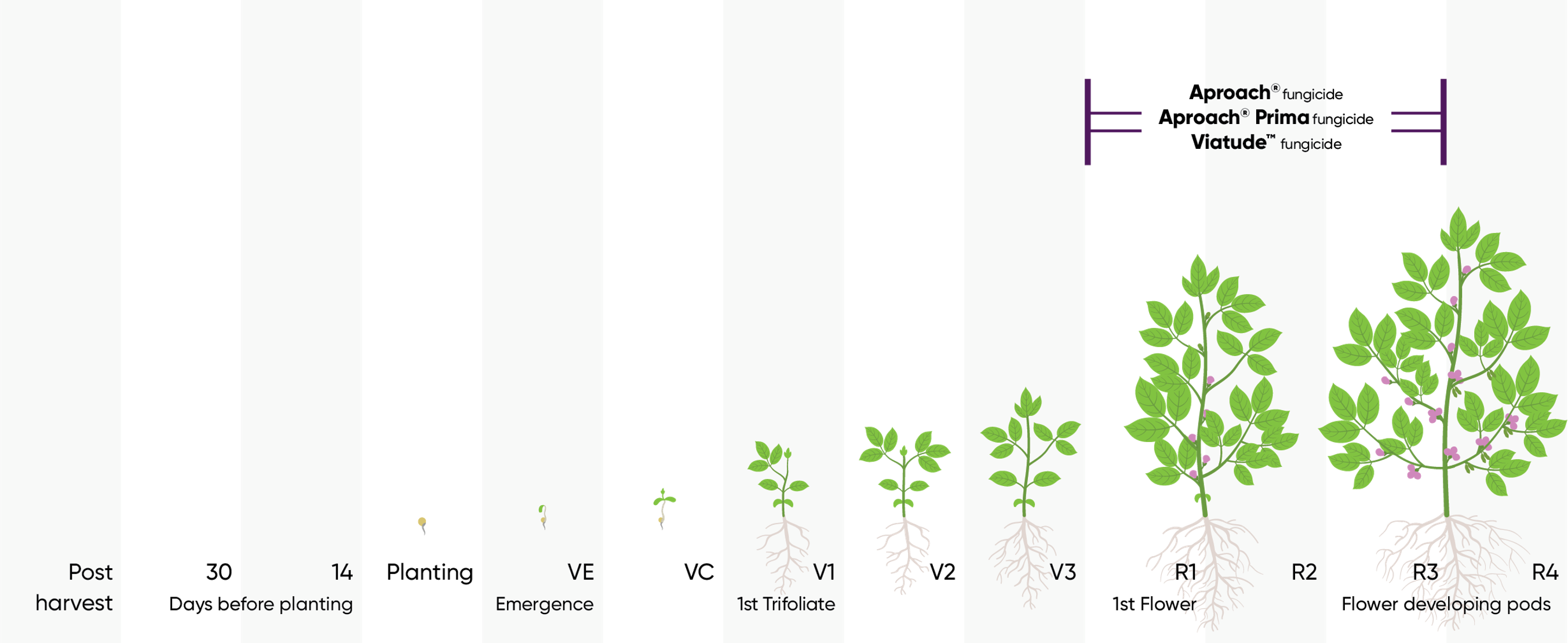White mold is an annual threat to soybeans in the northern United States (north of Interstate 70) from Nebraska to the Atlantic Coast, though it may appear anywhere when conditions are right. Yield losses begin with as little as 15% disease incidence and, with each additional 10% increase of disease incidence, an estimated yield loss increase of 2 to 5 bushels per acre can occur.1 Therefore, timely preventive action is necessary – and the best way – to protect yield from this disease.
The first signs of the disease are gray-to-white lesions at nodes. Lesions rapidly spread above and below infected nodes and are often covered in fluffy, white growths. Small black structures called sclerotia may also form on or in the stem. Sclerotia can be ⅛ inch to ¾ inch long and can survive harsh weather conditions as they harden with age.2
Under ideal white mold development conditions, it only takes one soybean crop to jump from 5% or 10% infected soybean plants in a field to 50% the following season. Correct disease diagnosis and implementing an effective management strategy will help minimize the spread of sclerotia and reduce the risk of severe disease in subsequent years.
These management practices can help:
- Prioritize preventative measures. Timely preventive action is necessary to protect yield in the presence of this disease. Prioritize preventative measures, such as planting varieties that feature tolerance to white mold, using fungicides with preventative activity, and more.
- Scout your fields. Weekly scouting is ideal to check the presence and progression of disease in your fields, especially during key reproductive stages. You’ll want to be in the field during R1 to R3 and R4 to R5 growth stages, especially if weather conditions favor white mold development.
- Use free phone applications. University of Wisconsin–Madison has developed Sporecaster to forecast disease risk. You enter operation-specific information, then the application will help identify the best timing for disease treatment.
- Space plants properly. In infested fields, 15-inch row spacing or wider and planting populations of 125,000 to 150,000 plants per acre can reduce chance of white mold development. Wider row spacing and lower plant populations increases air flow and help decrease humidity in the canopy and near the soil surface, which creates a less favorable environment for disease development.2
- Time fungicide applications wisely. Most fungicides are very effective for a two-to-three-week period. Timely applications can maximize the value of the application and reduce the need for return applications.
- Select a fast-acting fungicide. Corteva Agriscience offers two soybean fungicides that offer fast-acting white mold control.
- Aproach® fungicide provides uptake in plants nearly twice as fast as competitors, thanks to picoxystrobin. This active ingredient uses four movement properties to quickly surround, penetrate and protect soybean leaves and stems. And when weather and other crop demands make it difficult to time fungicide applications precisely, Aproach fungicide compensates with better coverage, preventive and curative activity, and residual control.
- Viatude® fungicide has the same proven active ingredient - Onmira® (picoxystrobin) - as Aproach plus prothioconazole for added white mold protection, strong plant health and higher yield potential. Watch this video to learn more about how Vitatude fungicide delivers the best-in-class white mold protection.
- Note: Viatude fungicide can be paired with Aproach fungicide in a two-pass system for even stronger plant health throughout the season.

- Harvest any infected fields last. Thoroughly clean equipment after leaving an infected field.
- Rotate with a nonhost crop to reduce disease pressure in a field. More than one year away from soybeans may be required to reduce white mold problems, depending on soybean tolerance, field history and other factors. Nonhost crops include corn, sorghum and small grains. Susceptible crops to avoid in a rotation include alfalfa, clover, sunflower, canola, edible beans and potatoes.
Consult your local Corteva Agriscience representative and check out our Corn & Soybean Disease ID Guide for more detailed management recommendations for white mold and common Midwest crop diseases.
1Soybean Diseases: Sclerotinia Stem Rot (White Mold). https://www.ndsu.edu/pubweb/~bernelso/soydiseases/sclerotinia.shtml Berlin D. Nelson, Professor, Department of Plant Pathology North Dakota State University, Fargo, ND
2Conrad, A., and D. Telenko. 2022. Diseases of Soybean: White Mold. https://www.extension.purdue.edu/extmedia/BP/BP-43-W.pdf
Aproach® Prima and Viatude® are not registered for sale or use in all states. Contact your state pesticide regulatory agency to determine if a product is registered for sale or use in your state. Always read and follow label directions.

